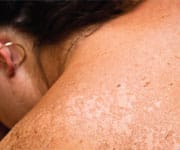Life Extension Magazine®

No matter where you live, the ongoing depletion of the ozone layer increases your risk of skin cancer.1
Over the past 40 years, melanoma cases increased 800% for women and 400% for men. Non-melanoma cases increased 153% for women and 64% for men.1,2 Skin cancer now accounts for over 40% of all cancers in the US.3
Topical sun blocks aren’t putting a dent in the rates of skin cancer. Thankfully, researchers have found a unique botanical extract that, taken internally, protects skin from solar damage and minimizes the potentially lethal DNA mutations that occur from sun exposure.
Nearly a decade of rigorous research and clinical trials has shown that the fern plant Polypodium leucotomos has the uncanny ability to shield the skin against the dangerous effects of ultraviolet (UV) exposure.4-9
Numerous studies demonstrate that Polypodium leucotomos reduces the number of sunburn cells following exposure to solar rays,6,7 protects against UV-induced DNA damage,6,10 reduces inflammation,6,10 influences the immune system,6,7,11,12 acts against tumors,13 and inhibits collagen-degrading enzymes.14,15
Polypodium leucotomos specifically targets the skin—protecting from sunburn, cell death, DNA damage, and oxidant activity from natural and artificial ultraviolet light.4,6,7,10 In addition, a new natural compound known as red orange complex has been shown to provide supplementary protection against UVB damage.16,17
In this article, you’ll learn how Polypodium leucotomos helps protect skin from the ultraviolet damage that leads to short-term damage (such as sunburn and sun poisoning) and long-term damage (such as wrinkles and skin cancer).
A Revolutionary Approach to Sun Protection

Current staggering skin cancer rates shows that sunscreens are not offering adequate protection against damaging solar rays.2
Scientists have found that an extract of the fern Polypodium leucotomos when taken internally, slows the rate of harmful UV rays penetrating the skin—and prevents the damage caused by rays when they do get through.4-8 Ultimately, this helps avoid cellular changes in the skin that lead to premature aging and cancer.9
Best of all, Polypodium leucotomos offers this protection from the inside out. The result is an oral photoprotective agent that provides uniform, cellular total-body surface protection (including the eyes, lips, and the scalp).
Oral Protection From Sunburn
Sunburn occurs when your skin is exposed too long to ultraviolet light. Although we don’t normally think of it in these terms, sunburn is literally inflammation of the skin. Over time, chronic inflammation is just as harmful to your skin (your body’s largest organ) as it is to any other organ in your body.
Unfortunately, the more sunburns your skin experiences early in life, the more you increase your risk of skin cancer later on.18 And of course, skin that is repeatedly overexposed to ultraviolet light is more prone to wrinkle, dry out, and age prematurely.19
It’s hard to imagine that swallowing a capsule could provide such potent protection from the sun’s harmful rays. But multiple studies have proven that taking oral Polypodium leucotomos can dramatically increase the amount of time you can spend in the sun before your skin becomes red and inflamed.6,7,20
One of the early clinical studies on Polypodium leucotomos determined that the oral extract offered significant protection against the sun’s rays.20 The study subjects experienced an almost three-fold increase in the amount of time they spent in the sun before their skin began to burn, compared to when they weren’t using any form of UV protection. Subjects taking medication associated with increased photosensitivity experienced even more impressive results—lengthening the amount of sunlight their skin could tolerate before damage occurred by nearly seven-fold.20
Another study confirmed the ability of Polypodium leucotomos to protect the skin against UV damage.6 This particular study consisted of subjects with fair to light skin, which means they were more vulnerable to sun damage in the first place.
The active group was administered the Polypodium leucotomos extract (7.5 mg/kg body weight, a dose that translates to 525 mg for a typical 154-pound person) and was then directly exposed to varying doses of artificial ultraviolet radiation. Once again, the subjects taking the Polypodium leucotomos extract experienced a significant decrease in the reddening of their skin—but the microscopic effects were even more impressive.6
Those who had taken the extract experienced less UV-induced damage, including significantly fewer sunburn cells, which are indicators of light-induced tissue injury. They had a reduction in the kind of DNA damage that can lead to cancer, and had a protective effect on radiation-sensitive Langerhans cells, key immune cells found in the outer layer of skin (the epidermis).6
What You Need to Know
 |
Plant Extracts Guard Against UV-Induced Skin Damage
- Ultraviolet (UV) radiation directly damages DNA and impairs normal skin cell functions, leading to premature skin aging, immune suppression, and cancer.
- Currently, the standard means of protection against UV rays include avoiding sun exposure and using sunscreen. However, despite warnings, skin cancer rates continue to climb.
- The fern plant Polypodium leucotomos and red orange extract offer a safe, easy, and effective way of shielding the skin against the dangerous effects of ultraviolet (UV) exposure in the form of an oral supplement.
- Polypodium leucotomos has powerful antioxidant effects that specifically target the skin—protecting the skin from sunburn, cell death, DNA damage, and oxidant activity from both natural and artificial ultraviolet light.
- Oral Polypodium leucotomos extracts provide a convenient way to protect your skin from short-term UV damage (such as sunburn and sun poisoning) and attenuate long-term UV damage (such as wrinkles and skin cancer).
- Red orange extracts exert an anti-inflammatory effect against human cells, including keratinocyte cells found in the epidermal skin layer.
- Human studies show that red orange complex provides photoprotection against UVB-induced skin erythema.
Protecting Against “Sun-Poisoning”
Polypodium leucotomos offers photoprotection against one of the most extreme forms of sun damage—sun poisoning. Those who suffer from sun poisoning can break out in a rash even after limited exposure to the sun. This condition is known as polymorphic light eruption, which belongs to a category of UV-induced skin disorders known as idiopathic dermatoses. In a recent study, 57 patients with idiopathic dermatoses took 480 mg per day of Polypodium leucotomos orally and then exposed themselves to sunlight.21 The Polypodium leucotomos extract significantly reduced symptoms in 73% of the subjects.
This study had nearly identical results to a previous study of patients with idiopathic dermatoses.8 In that study, the subjects took 480 mg of oral Polypodium leucotomos and then exposed themselves to sunlight—and an astounding 80% of the patients reported benefits from its use.
Prevent Wrinkles and Premature Aging
In study after study, Polypodium leucotomos has proven its ability to decrease the short-term consequences of sun exposure, such as redness and sunburn cell formation.6-8,11,12,21 But the long-term benefits are equally impressive.
Clinical research shows that taking oral Polypodium leucotomos extracts provide the skin with extraordinary protection from photoaging.6-8
UV rays wreak havoc on human skin, generating free radicals and other harmful substances that damage the DNA that is responsible for ensuring every skin cell fulfills its designated role—including the regeneration of healthy new skin cells.22 Ultraviolet light destroys specialized immune cells called Langerhans’ cells that are abundantly found in the skin22 and are responsible for destroying harmful substances such as germs, toxins, tumors, or other invaders before they can hurt the skin or penetrate further into the body.
If left unchecked, the result of this UV damage is skin that develops lines and wrinkles, sags, dries out, and thins—in other words, UV damage contributes to the premature aging of your skin.19 Fortunately, Polypodium leucotomos slows the absorption of harmful UV rays and diminishes the DNA damage inflicted by sun-generated free radicals—leading to long-term skin protection and promoting healthy, youthful skin.20
In a recent study, scientists studied the impact of Polypodium leucotomos on both UV radiated and non-radiated fibroblasts in vitro. They wanted to determine if it would have an effect on matrix metalloproteinases (MMPs), which are enzymes stimulated by UV light and that break down elastin and collagen the proteins that are responsible for keeping your skin supple and firm.14
The researchers determined that Polypodium leucotomos could both prevent and repair damaged skin. It prevents skin aging by directly inhibiting MMP expression (preventing the breakdown of collagen in the first place). It repairs damaged skin by stimulating the production of collagen and elastin.14,15
As an added bonus, Polypodium leucotomos extracts have been shown to inhibit protein-destroying skin enzymes that decrease skin elasticity, which could help delay the visible skin aging effect of ultraviolet radiation exposure.15 Additional research has found that Polypodium leucotomos decreases the development of damaging inflammation in the skin6,23 and increases survival of healthy skin cells.23,24
Misconception About How Skin is Damaged By the Sun
 |
Misconceptions can be deadly. If you think you can safely lie out in the sun as long as you are covered with a commercial sunscreen, the science indicates you are mistaken. Increasingly, studies suggest that no commonly available sunscreen completely prevents photodamage.36
Even if you choose to avoid sunbathing, typical everyday exposure (30 four-minute exposures over the course of a week) is equivalent to spending over two hours every week at the beach. In fact, everyday sun exposure is a causative factor in skin aging.37,38
With the onset of the long, sunny days of summer and the ongoing depletion of the Earth’s protective ozone layer, protecting your skin against solar radiation should be a priority. As the incidence of skin cancers and premature aging of the skin continues to increase to epidemic levels, taking aggressive steps to guard against sunlight-induced free radicals is of paramount importance.
Protection Against Skin Cancer
In addition to creating visibly damaged skin, unprotected sun exposure is the most preventable risk factor for skin cancer in the US.25 That’s because the same inflammation and DNA damage that can lead to the accelerated aging of the skin can lead to structural changes that can increase your risk of cancer.9
Fortunately, the same mechanisms of action in Polypodium leucotomos that protect the skin against sunburn and age-related sun damage has the potential to provide unprecedented long-term protection against skin cancer as well.4,6,7,10-15
One study found that Polypodium leucotomos helps preserve skin health by maintaining Langerhans cells, the specialized immune cells in the skin that scavenge toxins and debris.6,20 The extracts have also shown to reduce UV-induced DNA damage in skin cells that is associated with skin cancer.6,26
This means that taking an oral Polypodium leucotomos extract may allow for better DNA repair and subsequently fewer mutations that can initiate cancer.26
Based on these impressive results, the researchers concluded, “Oral administration of Polypodium leucotomos is an effective systemic chemophotoprotective agent leading to significant protection of skin against UV radiation.”6
How it Works
Polypodium leucotomos’s benefits for the skin are nothing new. For centuries, natives of Honduras have used the plant to protect themselves against sunburns, tumors, psoriasis, and other skin diseases. More recently, however, research has shown why this fern offers such powerful protection for your skin.
In an article published in Photochemical and Photobiological Sciences,5 Dr. Salvador Gonzalez, a renowned physician-researcher in dermatology and photo-medicine at Memorial Sloan-Kettering Cancer Center, reviewed several proposed mechanisms by which the natural ingredient appears to work:
- It inhibits free radicals. Polypodium leucotomos slows the proliferation of free radicals that are normally seen with sun exposure and normal metabolic processes throughout the body.4,5,27
- It prevents DNA damage.5 Polypodium leucotomos prevents damage to and decomposition of DNA and natural elements that protect the skin (such as Langerhans cells), and prevents UV rays from killing skin cells and supporting structures.5,27
- It acts as a powerful anti-inflammatory— especiallyin skin tissue.5
- It inhibits photo-immunosuppression.5 Polypodium leucotomos prevents UV rays from suppressing immune function, which is important in preventing harmful cellular changes that could lead to the development of skin cancer.6,11
Polypodium leucotomos not only has short-term effects such as inhibiting reactive oxygen species (free radicals) production and DNA damage, but the short-term effects “translate into long-term prevention of photoaging and photocarcinogenesis,” Dr. Gonzalez said.5
These mechanisms help explain why Polypodium leucotomos extracts are proving time and again to decrease the consequences of acute sun exposure such as redness, sunburn-cell formation, and the suppression of vital Langerhans cells.5-7
Supporting Compound Enhances the Effects
Various combinations of ultraviolet-protective antioxidants have intrigued researchers with their potential high-powered protective effects from solar damage.28 Fortunately, an extract from red oranges has been found to provide mechanisms to enhance the photoprotective effects of Polypodium leucotomos.
Red Orange Complex
Furthering protection from sun damage is a new standardized extract, Red Orange Complex, obtained from three Mediterranean red orange varieties (Citrus sinensis var. Moro, Tarocco, and Sanguinello). The main active compounds are phenolic compounds—including anthocyanins, flavanones and hydroxycinnamic acids (as well as ascorbic acid).16,29,30
Lab studies indicated that red orange complex exerts:
- An anti-inflammatory effect against human cells, including keratinocyte cells30,31—the predominant cell type in the skin epidermis;
- An anti-proliferative effect against human cancer cells in cell culture studies;32
- An inhibiting effect on UVB-induced apoptosis (cell death);33 and
- Potent antioxidant support, suggested to stem not from the individual antioxidants, but from a combined positive effect on the broader antioxidant complex-system.16,33

In vivo research has shown that red orange complex provides photoprotection against UVB-induced skin erythema.16,17
Supplementation with this complex was found to increase serum thiol groups—which are free radical quenchers—in individuals occupationally exposed to significant automobile exhaust pollution34 and to reduce oxidative stress in type II diabetic patients.35
These results prompted a clinical trial to study the photoprotective capacity of the extract. A group of 18 volunteers were enrolled in a study in which researchers measured the skin protective ability of 15 days of oral red orange complex supplementation against UVB-induced damage. The intensity of the induced erythema was found to be decreased by about 35%, demonstrating significant skin defense.17
The Benefits of Oral Sunblock*
 |
- It protects the entire skin surface, including the mucous membranes and the scalp.
- It cannot be rubbed off or removed by perspiring or bathing.
- It provides quick, easy sun protection for everyday use.
* If you’re planning on being in the sun for any period of time, it’s best to combine the use of oral Polypodium leucotomos extracts with a high-SPF sunscreen for added protection.
Summary
Photoprotection is crucial for preventing immune suppression, premature skin aging, and skin cancer. Sunscreens aren’t offering adequate protection against sun-induced skin damage.
Oral extracts from the fern Polypodium leucotomos and red oranges work from the inside out to shield the skin against the dangerous effects of ultraviolet (UV) exposure. Polypodium leucotomos has powerful effects that specifically target the skin—protecting against sunburn, cell death, DNA damage, and oxidation from natural and artificial ultraviolet light.
Based on the research studies, taking Polypodium leucotomos extract combined with red orange extract can protect your skin from short-term and long-term damage, such as sunburn, wrinkles, and skin cancer—all at the same time!
If you’re planning on being in the sun for long periods of time, or are just exposed to 20 minutes a day of everyday exposure, the oral ingestion of Polypodium leucotomos and red orange extracts affords considerable benefit. For prolonged periods of sun exposure a high-SPF sunscreen should be used for added protection.
Even diligent individuals are challenged to apply sunscreen to all parts of their skin that are exposed to UV rays, thus making systemic protection provided by internal protectors such as Polypodium leucotomos that much more important.
If you have any questions on the scientific content of this article, please call a Life Extension® Health Advisor at 1-866-864-3027.
Editor's Note
Science continues to evolve, and new research is published daily. As such, we have a more recent article on this topic: Oral Sunscreen Provides All-over Protection
References
- Available at: http://www.who.int/uv/faq/skincancer/en/index1.html. Accessed March 28. 2013.
- Reed KB, Brewer JD, Lohse CM, Bringe KE, Pruit CN, Gibson LE. Increasing incidence of melanoma among young adults: An epidemiological study in Olmsted County, Minnesota. Mayo Clinic Proceedings 2012;87(4):328-34.
- Available at: http://www.cdc.gov/excite/skincancer/mod10.htm. Accessed March 20, 2013.
- Gonzalez S, Alonso-Lebrero JL, Del Rio R, Jaen P. Polypodium leucotomos extract: a nutraceutical with photoprotective properties. Drugs Today (Barc). 2007 Jul;43(7):475-85.
- Gonzalez S, Gilaberte Y, Philips N. Mechanistic insights in the use of a Polypodium leucotomos extract as an oral and topical photoprotective agent. Photochem Photobiol Sci. 2010 Apr;9(4):559-63.
- Middelkamp-Hup MA, Pathak MA, Parrado C, et al. Oral Polypodium leucotomos extract decreases ultraviolet-induced damage of human skin. J Am Acad Dermatol. 2004 Dec;51(6)910-8.
- Middelkamp-Hup MA, Pathak MA, Parrado C, et al. Orally administered Polypodium leucotomos extract decreases psoralen-UVA-induced phototoxicity, pigmentation, and damage of human skin. J Am Acad Dermatol. 2004 Jan;50(1):41-9.
- Caccialanza M, Percivalle S, Piccinno R, Brambilla R. Photoprotective activity of oral Polypodium leucotomos extract in 25 patients with idiopathic photodermatoses. Photodermatol Photoimmunol Photomed. 2007 Feb;23(1):46-7.
- Ichihashi M, Ueda M, Budiyanto A, et al. UV-induced skin damage. Toxicology. 2003 Jul 15;189(1-2):21-39.
- González S, Pathak MA. Inhibition of ultraviolet-induced formation of reactive oxygen species, lipid peroxidation, erythema and skin photosensitization by Polypodium leucotomos. Photodermatol Photoimmunol Photomed. 1996 Apr;12(2):45-56.
- Siscovick JR, Zapolanski T, Magro C, et al. Polypodium leucotomos inhibits ultraviolet B radiation-induced immunosuppression. Photodermatol Photoimmunol Photomed. 2008 Jun;24(3):134-41
- Gonzalez S, Alcaraz MV, Cuevas J, et al. An extract of the fern Polypodium leucotomos (Difur) modulates Th1/Th2 cytokines balance in vitro and appears to exhibit anti-angiogenic activities in vivo: pathogenic relationships and therapeutic implications. Anticancer Res. 2000;20(3A):1567-75.
- Rodríguez-Yanes E, Juarranz Á, Cuevas J, Gonzalez S, Mallol J. Polypodium leucotomos decreases UV-induced epidermal cell proliferation and enhances p53 expression and plasma antioxidant capacity in hairless mice. Exp Dermatol. 2012 Aug;21(8):638-40.
- Philips N, Conte J, Chen YJ, et al. Beneficial regulation of matrixmetalloproteinases and their inhibitors, fibrillar collagens and transforming growth factor-beta by Polypodium leucotomos, directly or in dermal fibroblasts, ultraviolet radiated fibroblasts, and melanoma cells. Arch Dermatol Res. 2009 Aug;301(7):487-95.
- Philips N, Smith J, Keller T, Gonzalez S. Predominant effects of Polypodium leucotomos on membrane integrity, lipid peroxidation, and expression of elastin and matrixmetalloproteinase-1 in ultraviolet radiation exposed fibroblasts, and keratinocytes. J Dermatol Sci. 2003 Jun;32(1):1-9.
- Bonina FP, Saija A, Tomaino A, Lo Cascio R, Rapisarda P, Dederen JC, In vitro antioxidant activity and in vivo photoprotective effect of red orange extract. Int J Cosmet Sci. 1998;20:331-42.
- Bonina FP. Effect of the supplementation with Red Orange Complex® on ultraviolet-induced skin damage in human volunteers. Bionap Report. Santa Venerina, CT, Italy, 2008.
- Iannacone MR, Wang W, Stockwell HG, et al. Patterns and timing of sunlight exposure and risk of basal cell and squamous cell carcinomas of the skin--a case-control study. BMC Cancer. 2012 Sep 20;12:417.
- Sjerobabski Masnec I, Poduje S. Photoaging. Coll Antropol. 2008 Oct;32 Suppl 2:177-80.
- Gonzalez S, Pathak MA, Cuevas J, Villarrubia VG, Fitzpatrick TB. Topical or oral administration with an extract of Polypodium leucotomos prevents acute sunburn and psoralen-induced phototoxic reactions as well as depletion of Langerhans cells in human skin. Photodermatol Photoimmunol Photomed. 1997 Feb;13(1-2):50-60.
- Caccialanza M, Recalcati S, Piccinno R. Oral Polypodium leucotomos extract photoprotective activity in 57 patients with idiopathic photodermatoses. G Ital Dermatol Venereol. 2011 Apr;146(2):85-7.
- Lee CH, Wu SB, Hong CH, Yu HS, Wei YH. Molecular mechanisms of UV-induced apoptosis and its effects on skin residential cells: The implication in UV-based phototherapy. Int J Mol Sci. 2013 Mar 20;14(3):6414-35.
- Jaczyk A, Garcia-Lopez MA, Fernandez-Peñas P, et al. A Polypodium leucotomos extract inhibits solar-simulated radiation-induced TNF-alpha and iNOS expression, transcriptional activation and apoptosis. Exp Dermatol. 2007 Oct;16(10):823-9.
- Alonso-Lebrero JL, Dominguez-Jimenez C, Tejedor R, Brieva A, Pivel JP. Photoprotective properties of a hydrophilic extract of the fern Polypodium leucotomos on human skin cells. J Photochem Photobiol B. 2003 Apr;70(1):31-7.
- Available at: http://www.epa.gov/sunwise/uvandhealth.html. Accessed March 25, 2013.
- Emanuel P, Scheinfeld N. A review of DNA repair and possible DNA-repair adjuvants and selected natural anti-oxidants. Dermatol Online J. 2007;13(3):10
- Mulero M, Rodríguez-Yanes E, Nogués MR, et al. Polypodium leucotomos extract inhibits glutathione oxidation and prevents Langerhans cell depletion induced by UVB/UVA radiation in a hairless rat model. Exp Dermatol. 2008 Aug;17(8):653-8.
- Greul AK, Grundmann JU, Heinrich F, et al. Photoprotection of UV-irradiated human skin: an antioxidative combination of vitamins E and C, carotenoids, selenium, and proanthocyanidins. Skin Pharmacol Appl Skin Physiol. 2002 Sep-Oct;15(5):307-15.
- Rapisarda P, Tomaino A, Lo Cascio R, Bonina F, De Pasquale A, Saija A. Antioxidant effectiveness as influenced by phenolic content of fresh orange juices. J Agric Food Chem. 1999;47:4718-23.
- Venera C, Frasca G, Rizza L, Rapisarda P, Bonina F. Antiinflammatory effects of a red orange extract in human keratinocytes treated with interferon-gamma and histamine. Phytother Res. 2010;24:414-8.
- Frasca G, Panico AM, Bonina F, et al. Involvement of inducible nitric oxide synthase and cyclooxygenase-2 in the anti-inflammatory effects of a red orange extract in human chondrocytes. Nat Prod Res. 20 September 2010;24(15):1469-80.
- Vitali F, Pennisi C, Tomaino A, et al. Effect of a standardized extract of red orange juice on proliferation of human prostate cells in vitro. Fitoterapia. 2006 Apr;77(3):151-5.
- Cimino F, Cristania M, Saijaa A, Bonina FP, Virgili F. Protective effects of a red orange extract on UVB-induced damage in human keratinocytes. BioFactors. 2007;30:129-38.
- Bonina FP, Puglia C, Frasca G, et al. Protective effects of a standardized red orange extract on air pollution-induced oxidative damage in traffic police officers. Nat Prod Res. 2008;22(17,20):1544-51.
- Bonina FP, Leotta C, Scalia G, et al. Evaluation of oxidative stress in diabetic patients after supplementation with a standardised red orange extract. Diab Nutr Metab. 2002;15:14-9.
- Haywood R, Wardman P, Sanders R, Linge C. Sunscreens inadequately protect against ultraviolet-A-induced free radicals in skin: implications for skin aging and melanoma? J Invest Dermatol. 2003 Oct;121(4):862-8.
- Gasparro FP. Sunscreens, skin photobiology, and skin cancer: the need for UVA protection and evaluation of efficacy. Environ Health Perspect. 2000 Mar;108 Suppl 1:71-8.
- Dangoisse C. Dermo-cosmetics and prevention of skin aging. Rev Med Brux. 2004 Sep;25(4):A365-70.

